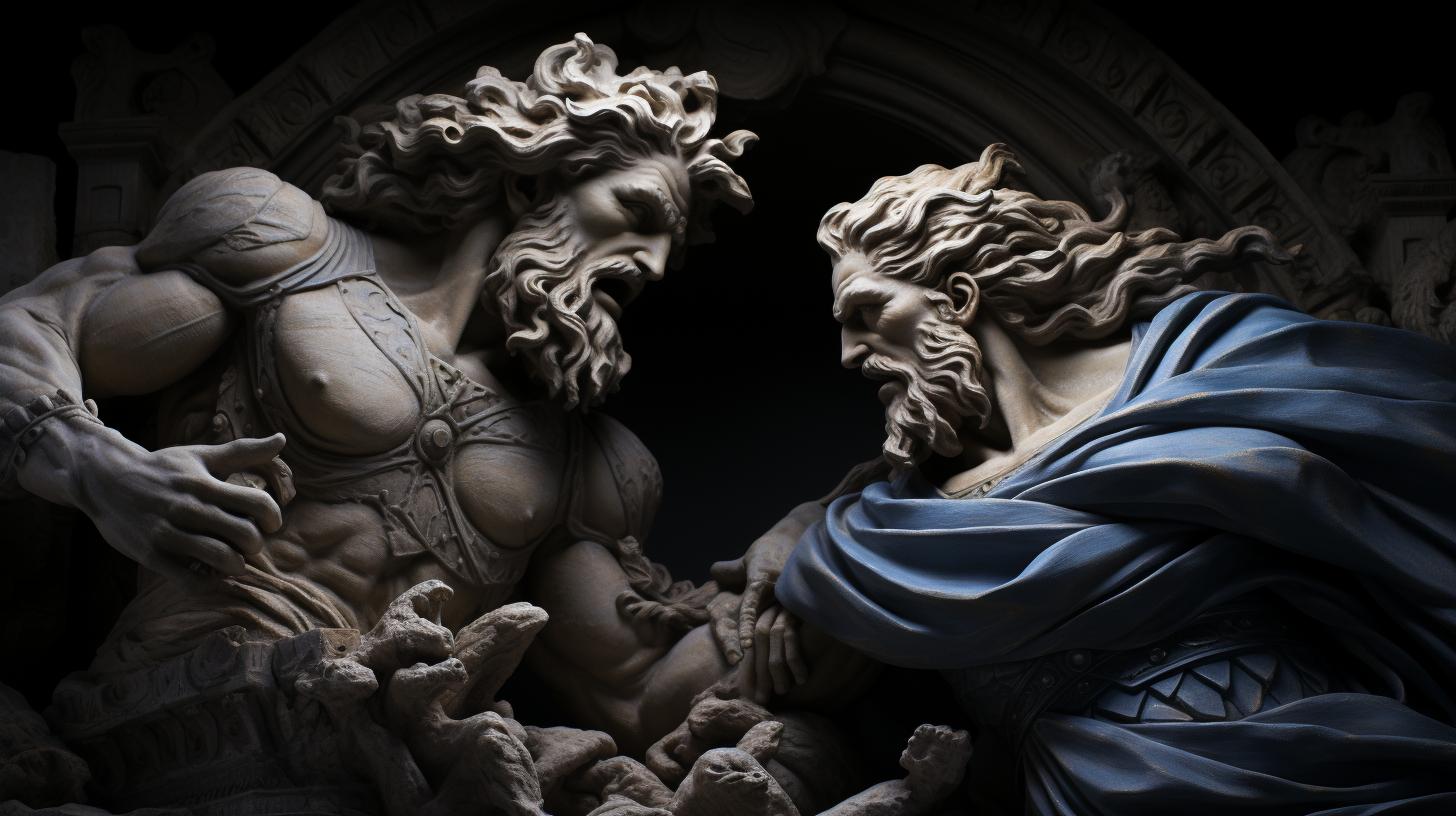Leto: The Greek Goddess and Mother of Apollo and Artemis

Leto, the Greek goddess, is known as the mother of Apollo and Artemis. She is the daughter of the Titans Coeus and Phoebe, and sister of Asteria.
According to Greek mythology, Zeus fathered the twins after being drawn to Leto’s hidden beauty. Leto faced numerous challenges during her pregnancy, including being rejected by lands under the order of Zeus’ jealous wife Hera. Despite the obstacles, Leto found refuge on the island of Delos, where she gave birth to Apollo and Artemis. Leto’s story extends beyond childbirth, showcasing her role as a maternal figure in the Olympian realm and her involvement in other notable myths.
Leto, a prominent figure in Greek mythology, holds the esteemed position of being the mother of two significant gods, Apollo and Artemis. Her origins trace back to her parents, the Titans Coeo and Febe, and she is the sister of Asteria.
As the myths suggest, Leto’s concealed beauty captivated Zeus, the king of the gods, and she became pregnant with the divine twins.
The Origin and Genealogy of Leto
Leto’s lineage can be traced to her Titan parents, Coeo and Febe. She is also the sibling of Asteria. Her family ties play a crucial role in shaping her position and impact in Greek mythology.
Zeus and Leto: The Birth of Apollo and Artemis
Leto’s relationship with Zeus resulted in the birth of Apollo and Artemis, making her their revered mother. This union between Leto and Zeus paves the way for numerous trials and tribulations Leto faces throughout her journey as a mother and goddess.
Leto’s Challenges and Struggles During Pregnancy
Leto’s pregnancy proved to be far from easy, as her husband Zeus’ jealousy stirred resentment in Hera, his wife. Hera’s orders made it impossible for Leto to find refuge or acceptance on any land.
Leto’s perseverance and determination to protect her unborn children shine through as she endured these hardships.
Leto’s Quest for Safe Birthplace: The Island of Delos
Facing rejection everywhere, Leto finally discovered solace on the remote island of Delos. This unique island, disconnected from the mainland and the ocean floor, provided a safe haven for Leto to give birth to her twins, Apollo and Artemis. Leto’s choice of Delos defied conventional notions of land and allowed her to fulfill her divine role as a mother.
Hera’s Jealousy and Pitón’s Pursuit of Leto
Driven by jealousy, Hera unleashed the monstrous serpent Pitón to torment and harm Leto during her pregnancy. Pitón’s relentless pursuit added to the challenges and dangers Leto faced while carrying the divine twins.
Leto’s Endurance: Delayed Birth and Maternal Agony
In certain variations of the myth, Hera’s interference led to the delayed birth of Apollo and Artemis, causing Leto agonizing days of waiting. Leto’s strength and endurance during this time showcase her unwavering maternal love and resolve.
Leto’s Role as a Maternal Figure in the Olympian Realm
After the birth and maturation of her children, Leto assumed a maternal role in the realm of the Olympian gods. She offered guidance and support to Apollo and Artemis, becoming a nurturing and protective presence among the gods.
Leto in Other Mythological Stories
Leto’s presence extends beyond her role as the mother of Apollo and Artemis. She is involved in various mythological tales that highlight her transformative power, her response to hubris, and the protection provided by her children.
These stories reveal the depth and significance of Leto’s character within Greek mythology.
Leto’s Transformative Power: The Tale of the Lycian Farmers
One notable myth involving Leto showcases her transformative abilities. When a group of Lycian farmers refused to provide water to Leto and her children, she displayed her divine power as punishment.
Leto transformed the farmers into frogs, forever dwelling in the waters they had selfishly denied her and her little ones.
Niobe’s Hubris and Leto’s Retribution
The story of Niobe, a queen who boasted of being a superior mother to Leto, highlights the consequences of arrogance. In response to Niobe’s hubris, Leto called upon her twin children to avenge her honor.
Apollo and Artemis unleashed their arrows, taking the lives of all of Niobe’s sons and daughters. Leto’s retribution served as a reminder of the importance of humility and respect in the face of divine power.
Ticio’s Assault on Leto: Apollo and Artemis’ Intervention
Another tale involving Leto focuses on her encounter with the giant Ticio. Seeking to violate her, Ticio faced the wrath of Apollo and Artemis. The twins swiftly intervened, defeating Ticio and ensuring Leto’s safety.
This story demonstrates the protective nature of Leto’s children and their unwavering commitment to safeguarding their mother, solidifying their bond as a divine family unit.
Leto’s Worship and Symbolism
Leto’s significance in Greek mythology extends beyond her role as a mother. She is worshipped and holds deep symbolism in various aspects of ancient Greek culture. Let’s explore her sacred island, her divine attributes, and her worship in different regions.
Leto’s Sacred Island: Delos and Its Importance
Delos, an island in the Aegean Sea, holds immense importance in the worship of Leto. Considered her sacred refuge, Delos played a crucial role in Leto’s quest for a safe birthing place.
The island’s status as a separate entity, untethered to the land or the ocean’s depths, allowed Leto to bring forth Apollo and Artemis there. Delos became a sanctuary dedicated to Leto and became a focal point of pilgrimage.
Leto as a Kourotrophic Deity
A key aspect of Leto’s worship is her role as a kourotrophic deity, a goddess of motherhood and child-rearing. Leto embodies the nurturing and protective qualities associated with motherhood. Her devotees sought her blessings for safe pregnancies, childbirth, and the well-being of their children.
Leto’s maternal presence offered solace and guidance to those navigating the journey of parenthood.
Leto’s Worship in Licia and Roman Equivalence as Latona
In the region of Licia, Leto held a special place as a revered mother goddess. She was worshipped alongside her twin children, Apollo and Artemis, and was regarded as a source of fertility and abundance.
In Roman mythology, Leto’s equivalent is Latona. As Latona, she maintained a similar significance in Roman culture and her worship was intertwined with the traditions and beliefs of the Romans.
Leto’s Depiction in Ancient Art: Modesty and Veiled Presence
In ancient art, Leto is often depicted as a modest and veiled figure in the presence of her children and Zeus. Artists captured her graceful and serene demeanor, representing her as a devoted mother.
Leto’s portrayal reflected the reverence and respect accorded to her as a maternal deity, and her depiction in art served as a visual testament to her importance in Greek mythology.
Leto’s Significance in Greek Mythology: The Symbolism of Motherhood
Leto’s significance in Greek mythology lies in her embodiment of motherhood. As the mother of Apollo and Artemis, she symbolizes the power of creation, nurturing, and protection. Leto’s journey through challenging pregnancy and her unwavering commitment to her children highlight the strength and resilience of motherhood.
Her position in the Olympian realm and her involvement in various mythological stories underscore the essential role she plays as a maternal figure in Greek mythology.
.




















